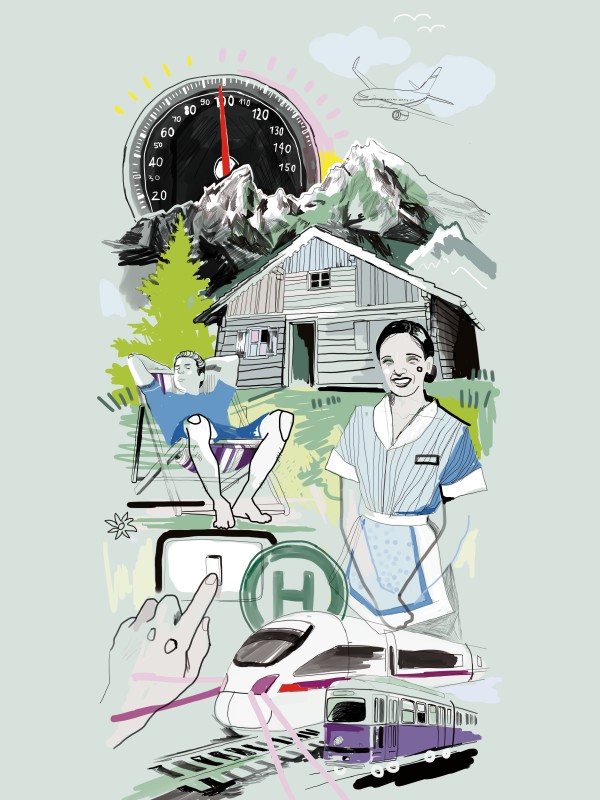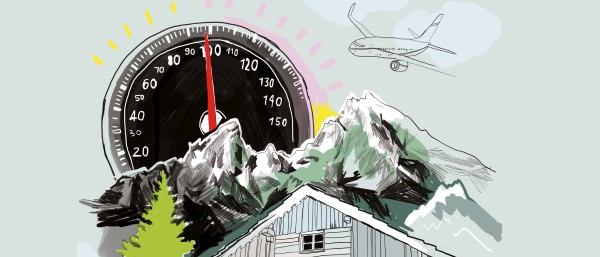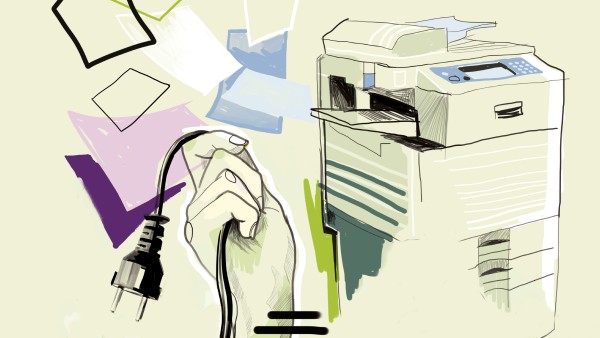Climate change affects us all. Everyone can play a part to contain the climate crisis. So what can each of us do? Our guide contains 50 tips from different areas of life that will help you to act responsibly. Be inspired by our suggestions in the four categories "buy & consume", “drive & fly”, "live & reside" and "work & earn". This is part 2 of our KfW Stories climate action guide with suggestions in the category “drive & fly”.

Use bus and train, avoid flights. Especially in the area of mobility, each individual can make his or her own contribution to the climate.
16. Avoid flying or compensate for the emissions
Flying is responsible for two to five per cent of global CO₂ emissions. And it is growing every year. Switch to the train for short trips! If flying is unavoidable, atmosfair.de calculates and offsets the emissions – you pay for the greenhouse gases caused by your flight. The money is invested in solar, hydropower or energy-saving projects in developing countries to reduce emissions of gases with a comparable impact on the climate.
17. Take holidays closer to home
If a father, mother and child fly from Frankfurt to Mallorca (and back again), they collectively release more CO₂ into the atmosphere than one person in India in a year. Next time, don’t shorten your holiday, shorten the distance to your destination! How well do you know your own region? Germany? Our neighbours? If you don’t want to take cycling holiday, train and long-distance bus have the best environmental footprint.
18. Slow it down
The harder you step on the gas pedal, the greater the aerodynamic drag is and the greater the consumption of fuel is. The ideal speed is around 100 km/h for combustion engines. With electric cars, the most energy-efficient speed is 30 to 90 km/h.
19. Responsible holidaymaking
More than 400 labels around the world identify green hotels and types of trips. The German label “CSR Tourism Certified” identifies providers that guarantee fair working conditions in the destination countries as well as environmental protection.
20. Scooter instead of a car?
E-scooters are intended to reduce car traffic in city centres. In many cities, however, this isn’t the outcome. Instead, fewer city bikes are rented. This is not a welcome trend considering that an e-scooter rider causes a quarter of the greenhouse gas emissions of a car driver per kilometre.
21. Switch it up!
Ask yourself the question every time: do I really need to make the trip in my own car? Particularly in the city, the vast majority of trips can be made by public transport, car sharing and cycling. Or just walk!

Switch off your lights and unplug devices at home when you go on holiday.
22. Pull the plug, close the door!
The climate footprint of a trip also depends on how you left your home. Pay attention to these obvious things: switch off all the lights, pull out all the plugs or the multi-socket outlets (except for the refrigerator and freezer, all electrical appliances should be unplugged), switch off the heating completely or set it to low in winter and close the windows.
23. Commute less
Around 12.5 million Germans commute to work every day by car – an average of 34 kilometres there and back. If only ten per cent of 220 working days were spent working from home, billions of car kilometres and about 1.8 million tonnes of CO₂ could be avoided.
24. Bypass traffic
German drivers are stuck in traffic jams for an average of 120 hours a year, 1.7 billion litres of fuel are consumed during this time, 96 litres per vehicle. Apps like StauMobil or Waze warn and redirect drivers in advance.
25. The airline makes the difference
For many years, it has been easy to get information about the CO₂ track record of a car. This was not possible for a long time for air travel – until the Atmosfair Airline Index came along. It ranks the 190 largest airlines by efficiency class each year. The list is freely available online.
26. E-cars vs combustion engines
The carbon footprint of cars doesn’t just include the exhaust gases emitted during driving. It also includes the emissions released during material production and fuel production. In a comprehensive analysis, the Federal Ministry for the Environment concludes that an electric car bought today performs better than a combustion engine from a climate perspective – even given the current German electricity mix. Compared to a modern diesel engine, the CO2 advantage of an e-car is 16 per cent, compared to a modern petrol engine 27 per cent. The advantage of the e-car will be even greater if the electricity mix is expected to be greener.
Published on KfW Stories: 6 October 2020







Data protection principles
If you click on one of the following icons, your data will be sent to the corresponding social network.
Privacy information